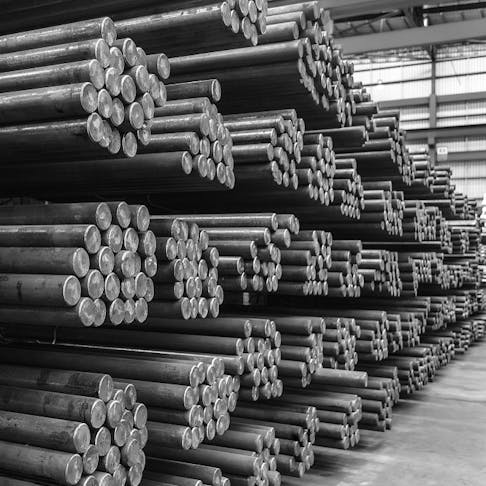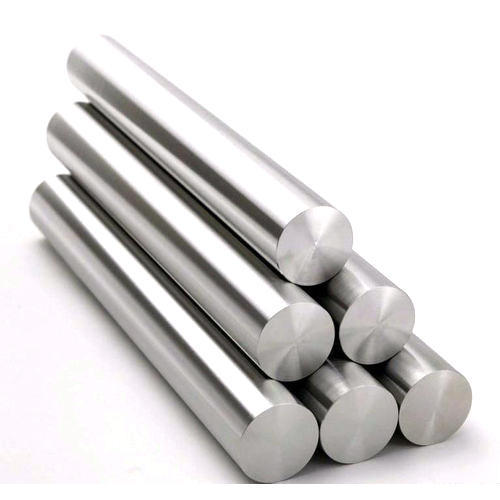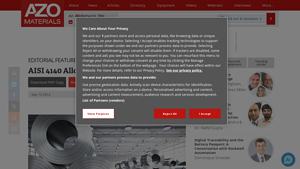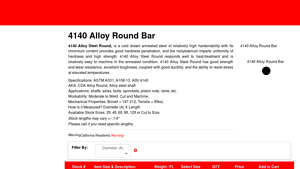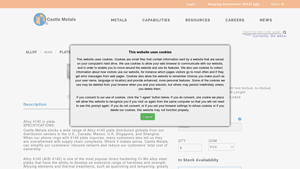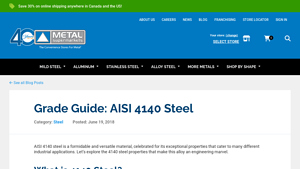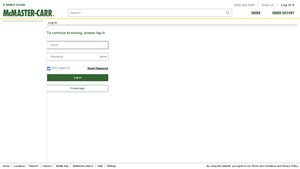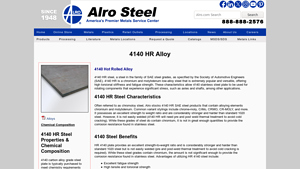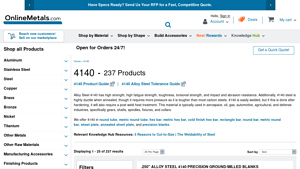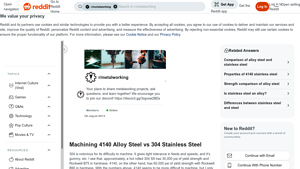4140 Alloy Guide: Type, Cost, Top List…
Introduction: Navigating the Global Market for 4140 alloy
In the competitive landscape of global manufacturing, sourcing 4140 alloy steel can be a daunting task for B2B buyers. This low-alloy steel, known for its exceptional toughness and high fatigue strength, is essential for various applications, including automotive components, machinery, and construction equipment. However, navigating the complexities of supplier options, quality standards, and pricing can pose significant challenges, especially for international buyers from regions like Africa, South America, the Middle East, and Europe.
This comprehensive guide aims to empower B2B buyers by providing in-depth insights into 4140 alloy steel. We will explore the different types of 4140 steel available, their specific applications, and the critical factors to consider when selecting suppliers. Additionally, we will cover essential aspects such as cost analysis, certification requirements, and best practices for quality assurance. By equipping buyers with actionable knowledge, this guide seeks to facilitate informed purchasing decisions, ultimately enhancing operational efficiency and product reliability.
Understanding the nuances of 4140 alloy steel not only aids in better sourcing but also enables companies to leverage the material’s unique properties for competitive advantage. As you delve into this guide, you will gain the confidence needed to navigate the global market effectively and make strategic investments in high-quality materials.
Understanding 4140 alloy Types and Variations
| Type Name | Key Distinguishing Features | Primary B2B Applications | Brief Pros & Cons for Buyers |
|---|---|---|---|
| 4140 Annealed | Softened for easier machining; high ductility | Automotive components, gears, and axles | Pros: Excellent machinability; good for forming. Cons: Lower strength compared to heat-treated variants. |
| 4140 Heat-Treated | Enhanced strength and hardness through heat treatment | High-stress applications, such as shafts and spindles | Pros: Superior strength; ideal for heavy-duty use. Cons: More challenging to machine; may require special tools. |
| 4140 Cold Drawn | Improved dimensional tolerances and surface finish | Precision components, fasteners, and fittings | Pros: Tight tolerances; enhanced surface quality. Cons: Higher cost; limited availability in certain regions. |
| 4140 Hot Rolled | Lower cost; generally less precise than cold drawn | Structural components, general fabrication | Pros: Cost-effective; readily available. Cons: Poorer surface finish; less strength than cold drawn. |
| 4140 Alloyed with Lead (41L40) | Increased machinability due to lead addition | Complex machined parts requiring high precision | Pros: Easier to machine; good for intricate designs. Cons: Reduced weldability; limited applications due to lead content. |
What Are the Key Characteristics of 4140 Annealed Alloy Steel?
4140 Annealed alloy steel is primarily characterized by its softness and high ductility, achieved through an annealing process. This makes it particularly suitable for applications that require extensive machining, such as automotive components, gears, and axles. Buyers should consider that while it offers excellent machinability, its strength is lower than that of heat-treated variants, making it less ideal for high-stress applications.
How Does 4140 Heat-Treated Alloy Steel Stand Out?
4140 Heat-Treated alloy steel is distinguished by its enhanced strength and hardness, making it suitable for high-stress applications like shafts and spindles. The heat treatment process significantly increases its performance under load, which is critical in demanding environments. However, buyers should be aware that this type can be more challenging to machine, often requiring specialized tools and techniques.
What Advantages Does 4140 Cold Drawn Alloy Steel Offer?
4140 Cold Drawn alloy steel is recognized for its improved dimensional tolerances and superior surface finish compared to other forms. It is often used in precision components, fasteners, and fittings where exact measurements are crucial. While it provides higher quality, the cost is typically greater, and availability may vary by region, making it essential for buyers to assess their specific needs and budget.
Why Choose 4140 Hot Rolled Alloy Steel?
4140 Hot Rolled alloy steel is a cost-effective option that is widely available and utilized in structural components and general fabrication. While it is more affordable, it generally offers a poorer surface finish and lower strength compared to cold-drawn options. Buyers should weigh the trade-off between cost and performance, especially in applications where surface quality is less critical.
What Are the Considerations for 4140 Alloyed with Lead (41L40)?
4140 alloyed with lead, known as 41L40, features increased machinability due to the lead addition, making it ideal for complex machined parts that require high precision. However, buyers must consider its reduced weldability and limited applications due to the presence of lead, which may restrict its use in certain industries. This variant is best suited for applications where intricate designs are necessary, and welding is not a primary concern.
Key Industrial Applications of 4140 alloy
| Industry/Sector | Specific Application of 4140 alloy | Value/Benefit for the Business | Key Sourcing Considerations for this Application |
|---|---|---|---|
| Automotive | Drive shafts and axles | Enhanced strength and durability under stress | Ensure compliance with automotive industry standards; consider heat treatment options. |
| Manufacturing | Gears and spindles | High wear resistance and performance longevity | Evaluate the machinability and availability of various forms (bars, plates). |
| Oil and Gas | Drill rods and casing components | Ability to withstand extreme conditions and loads | Assess corrosion resistance and sourcing from reliable suppliers with certifications. |
| Construction | Structural components like beams and brackets | High tensile strength for load-bearing applications | Look for custom sizes and finishes to meet project specifications. |
| Aerospace | Landing gear and structural parts | Critical performance in high-stress environments | Verify compliance with aerospace material specifications and quality assurance processes. |
How is 4140 Alloy Used in the Automotive Industry?
In the automotive sector, 4140 alloy is primarily used for manufacturing drive shafts and axles. Its high tensile strength and toughness enable it to withstand significant stresses encountered during vehicle operation. Buyers in this industry need to ensure that the alloy meets specific automotive standards, particularly regarding heat treatment and mechanical properties. Additionally, international buyers should consider sourcing from suppliers who can provide detailed certifications and quality assurance documentation.
What are the Applications of 4140 Alloy in Manufacturing?
Manufacturers utilize 4140 alloy for producing gears and spindles due to its excellent wear resistance and durability. These components often operate under high loads and require materials that can maintain performance over time. When sourcing 4140 alloy, businesses should focus on the machinability of the material, ensuring it can be easily processed into the desired shapes. Availability in various forms, such as bars and plates, is also a crucial consideration for manufacturers looking to streamline their production processes.
How Does 4140 Alloy Benefit the Oil and Gas Sector?
In the oil and gas industry, 4140 alloy is critical for manufacturing drill rods and casing components. The material’s ability to endure extreme conditions, including high pressures and corrosive environments, makes it ideal for this sector. Buyers should prioritize sourcing from suppliers who can guarantee corrosion resistance and provide comprehensive material certifications. Ensuring that the alloy meets industry-specific standards is vital for maintaining operational integrity in challenging environments.
What Role Does 4140 Alloy Play in Construction?
In construction, 4140 alloy is often used for structural components such as beams and brackets. Its high tensile strength allows for reliable load-bearing capabilities, essential for ensuring the safety and stability of structures. Buyers in this sector should look for suppliers that can offer custom sizes and finishes tailored to their specific project requirements. Additionally, understanding the local regulations and standards for construction materials is crucial for international buyers.
Why is 4140 Alloy Important in Aerospace Applications?
The aerospace industry employs 4140 alloy for critical components like landing gear and other structural parts. The material’s performance under high-stress conditions is essential for ensuring the safety and reliability of aircraft. Buyers must ensure compliance with stringent aerospace material specifications and quality assurance processes. Sourcing from reputable suppliers who understand these requirements can significantly impact the success of aerospace projects.
3 Common User Pain Points for ‘4140 alloy’ & Their Solutions
Scenario 1: Difficulty in Identifying the Right 4140 Alloy Specifications
The Problem: B2B buyers often struggle to identify the correct specifications for 4140 alloy steel tailored to their specific application needs. With varying grades and treatments available, such as annealed or quenched and tempered, buyers risk selecting the wrong material, which can lead to project delays, increased costs, or even component failure. This scenario is particularly challenging for companies in regions with less access to technical resources or local suppliers who might not be able to provide comprehensive product information.
The Solution: To effectively navigate the specifications of 4140 alloy, buyers should begin by thoroughly understanding their application requirements, including load-bearing capacities, environmental conditions, and manufacturing processes. Engaging directly with material suppliers can provide invaluable insights. Requesting detailed datasheets and technical support from manufacturers can help clarify which grade and treatment of 4140 will best suit specific applications. Additionally, investing in material testing and validation can ensure that the selected alloy meets performance standards, preventing costly mistakes down the line.
Scenario 2: Challenges in Machinability and Processing of 4140 Alloy
The Problem: Machining 4140 alloy can present challenges due to its toughness and hardness, particularly in its normalized or quenched states. Buyers may find that their machining operations lead to excessive tool wear, poor surface finishes, or unexpected dimensional inaccuracies. This issue is particularly pronounced in regions where skilled machining labor is scarce or where there is limited access to advanced machinery capable of handling tougher materials.
The Solution: To mitigate machining challenges, buyers should consider pre-treating 4140 alloy before machining. This can involve annealing the material to improve its ductility and reduce hardness, making it easier to machine. Furthermore, selecting the right cutting tools, such as high-speed steel or carbide tools, specifically designed for alloy steels can enhance machining efficiency. Implementing proper coolant strategies will also help in maintaining tool integrity and achieving optimal surface finishes. Finally, collaborating with experienced machinists or seeking partnerships with specialized machine shops can further streamline the process and ensure high-quality results.
Scenario 3: Concerns Over Availability and Lead Times for 4140 Alloy Steel
The Problem: B2B buyers often face long lead times and unpredictable availability of 4140 alloy steel, especially when sourcing from international suppliers. This issue can lead to production bottlenecks and a cascading effect on project timelines, particularly for companies operating in sectors like automotive or heavy machinery where timely delivery is crucial.
The Solution: To address availability concerns, buyers should establish relationships with multiple suppliers across different regions to diversify their sourcing options. Engaging with local distributors who maintain stock of 4140 alloy can help minimize lead times. Additionally, buyers should consider forecasting their material needs based on historical data and upcoming projects to negotiate better terms with suppliers for bulk purchases or consignment stock. Implementing just-in-time (JIT) inventory practices can also enhance supply chain efficiency and reduce the impact of lead time variability. By proactively managing their supply chain and building robust relationships with suppliers, companies can ensure a steady flow of 4140 alloy steel as needed.
Strategic Material Selection Guide for 4140 alloy
What are the Key Properties of 4140 Alloy Steel for B2B Applications?
4140 alloy steel is renowned for its unique combination of strength, toughness, and wear resistance, making it a favored choice in various industrial applications. The material’s composition includes chromium and molybdenum, which enhance its mechanical properties. Notably, it has a yield strength of approximately 415 MPa and a hardness rating of 197 Brinell, ensuring it can withstand significant stress and strain. The alloy’s medium carbon content (0.38% – 0.43%) contributes to its heat treatment capabilities, allowing it to be hardened for demanding applications.
What are the Pros and Cons of Using 4140 Alloy Steel?
When considering 4140 alloy steel for manufacturing, several pros and cons come into play.
Pros:
– Durability: The high tensile strength and fatigue resistance make it ideal for rotating components like axles and gears.
– Versatility: It can be heat-treated to enhance its properties, making it suitable for a wide range of applications.
– Cost-Effectiveness: Compared to other high-strength materials, 4140 offers a good balance between performance and cost.
Cons:
– Weldability Issues: The alloy’s higher carbon content can make it challenging to weld, requiring preheating and post-weld heat treatment.
– Manufacturing Complexity: The need for specific heat treatments can complicate manufacturing processes, potentially increasing lead times.
– Corrosion Resistance: While it offers some resistance, 4140 is not as corrosion-resistant as stainless steels, necessitating protective coatings in certain environments.
How Does 4140 Alloy Steel Impact Specific Applications?
The performance of 4140 alloy steel can significantly influence its suitability for various applications. For instance, its high strength makes it ideal for heavy-duty machinery components, while its machinability rating of 65% allows for efficient processing into complex shapes. However, the material’s susceptibility to corrosion means that applications in harsh environments, such as marine or chemical processing, may require additional protective measures.
What Should International B2B Buyers Consider When Sourcing 4140 Alloy Steel?
For international buyers, particularly from regions like Africa, South America, the Middle East, and Europe, several considerations are crucial. Compliance with local and international standards (e.g., ASTM, DIN, JIS) is essential to ensure material quality and performance. Buyers should also be aware of the common specifications for 4140, such as AISI 4140 and its equivalents like 42CrMo4 in Europe. Additionally, understanding the local market dynamics, including availability and pricing, can aid in making informed purchasing decisions.
Summary Table of 4140 Alloy Steel Properties
| Material | Typical Use Case for 4140 alloy | Key Advantage | Key Disadvantage/Limitation | Relative Cost (Low/Med/High) |
|---|---|---|---|---|
| 4140 Alloy Steel | Automotive components (axles, gears) | High strength and toughness | Poor weldability | Medium |
| 4140 Alloy Steel | Heavy machinery parts | Versatile heat treatment options | Increased manufacturing complexity | Medium |
| 4140 Alloy Steel | Structural applications | Cost-effective compared to alternatives | Limited corrosion resistance | Medium |
| 4140 Alloy Steel | Tooling and dies | Good machinability | Requires protective coatings in harsh environments | Medium |
This comprehensive analysis of 4140 alloy steel provides B2B buyers with actionable insights into material selection, ensuring they can make informed decisions tailored to their specific industry needs.
In-depth Look: Manufacturing Processes and Quality Assurance for 4140 alloy
What Are the Main Stages in the Manufacturing Process of 4140 Alloy Steel?
The manufacturing process for 4140 alloy steel involves several critical stages that ensure the material meets the required specifications for various industrial applications. Understanding these stages is essential for B2B buyers who prioritize quality and performance in their procurement.
Material Preparation: What Steps Are Involved?
The journey begins with the preparation of raw materials, primarily iron, carbon, chromium, and molybdenum. These materials are sourced from reputable suppliers to ensure compliance with international standards. The first step is to melt the raw materials in an electric arc or basic oxygen furnace at temperatures exceeding 1500°C. This process allows for the uniform mixing of elements, crucial for achieving the desired mechanical properties.
Once melted, the alloy is poured into molds to form billets or slabs. These shapes are then subjected to an annealing process, where they are reheated and cooled in a controlled environment. This step enhances the steel’s ductility, making it easier to work with in subsequent stages.
How Is 4140 Alloy Steel Formed?
The forming stage encompasses various techniques, including hot rolling, cold drawing, and machining. Hot rolling is often employed to produce bars and plates, which are then further processed to achieve specific dimensions. For instance, round bars are formed through continuous casting and then rolled to desired diameters.
Cold drawing is another technique used to enhance dimensional accuracy and surface finish. In this process, the steel is pulled through dies to achieve tighter tolerances. Machining, often performed on CNC machines, allows for the production of intricate components such as gears and shafts that require high precision.
What Finishing Techniques Are Commonly Used?
Finishing techniques play a vital role in enhancing the properties of 4140 alloy steel. Common methods include surface hardening, polishing, and coating. Heat treatment processes such as quenching and tempering are critical to improving hardness and tensile strength. After treatment, the steel may undergo surface treatment to improve corrosion resistance, a crucial factor for components exposed to harsh environments.
How Is Quality Assurance Implemented in 4140 Alloy Manufacturing?
Quality assurance (QA) is paramount in the manufacturing of 4140 alloy steel, ensuring that the final products meet both domestic and international standards. B2B buyers should be familiar with the various quality checkpoints and standards that govern this process.
What International Standards Should Buyers Be Aware Of?
Manufacturers of 4140 alloy steel often adhere to international standards such as ISO 9001, which outlines criteria for a quality management system. Compliance with these standards ensures that processes are continuously monitored and improved. Additionally, industry-specific certifications such as CE marking (for compliance in the European market) and API (American Petroleum Institute) standards are critical for products used in specific sectors like oil and gas.
What Are the Key Quality Control Checkpoints?
Quality control (QC) checkpoints are integral throughout the manufacturing process. Common checkpoints include:
-
Incoming Quality Control (IQC): This stage verifies the quality of raw materials before they enter the production process. Suppliers are often required to provide certificates of analysis to confirm compliance with specified standards.
-
In-Process Quality Control (IPQC): During manufacturing, regular inspections are conducted to ensure that processes remain within defined parameters. This includes monitoring temperature during melting and checking dimensions during forming.
-
Final Quality Control (FQC): Once the products are complete, final inspections are performed, which may include non-destructive testing (NDT) methods like ultrasonic testing or magnetic particle inspection to detect internal or surface defects.
How Can B2B Buyers Verify Supplier Quality Control?
For international B2B buyers, especially those from regions like Africa, South America, the Middle East, and Europe, verifying supplier quality is essential to mitigate risks associated with procurement.
What Methods Exist for Supplier Audits and Reports?
Buyers should conduct regular audits of their suppliers to ensure compliance with quality standards. This can involve on-site inspections, where buyers assess the manufacturing process and quality control measures firsthand. Additionally, requesting detailed quality reports and certificates from suppliers can provide insight into their QA practices.
Third-party inspections can also serve as a valuable tool for buyers. Engaging independent inspection agencies to verify product quality before shipment can help mitigate risks, especially when dealing with suppliers in regions with varying standards.
What Are the QC and Certification Nuances for International Transactions?
Navigating the complexities of international quality assurance can be challenging. B2B buyers must be aware of the specific certifications recognized in their respective markets. For instance, while ISO certifications are universally acknowledged, certain industries may have additional requirements. Understanding these nuances can help buyers make informed decisions and ensure that their suppliers meet the necessary quality benchmarks.
Conclusion: Ensuring Quality in 4140 Alloy Steel Procurement
The manufacturing processes and quality assurance measures for 4140 alloy steel are fundamental to ensuring that the material meets the high-performance standards required by various industries. By understanding the key stages of manufacturing and the importance of quality control, B2B buyers can make informed procurement decisions that align with their operational needs. Regular audits, thorough supplier evaluations, and adherence to international standards are critical strategies for ensuring quality in the procurement of 4140 alloy steel.
Practical Sourcing Guide: A Step-by-Step Checklist for ‘4140 alloy’
Introduction
This guide serves as a comprehensive checklist for B2B buyers looking to procure 4140 alloy steel. With its exceptional strength and versatility, 4140 alloy is widely used in various industries, particularly in components that endure high stress. This checklist will help you navigate the sourcing process effectively, ensuring that you acquire the right material from reliable suppliers.
Step 1: Define Your Technical Specifications
Clearly outline your requirements. Before initiating the sourcing process, it’s vital to define the specific technical specifications you need for 4140 alloy. Consider factors such as dimensions, form (bars, plates, sheets), and any particular surface treatments required. This clarity will help suppliers provide accurate quotes and minimize misunderstandings.
- Consider your application: Identify whether you need the alloy for high-tensile components, like axles or shafts, or for load-bearing parts like bolts.
- Specify quality standards: Determine if you need to adhere to any international or regional standards, such as ASTM or DIN.
Step 2: Research Potential Suppliers
Conduct thorough market research. Start by compiling a list of potential suppliers who specialize in 4140 alloy steel. Utilize online directories, industry publications, and trade shows to identify reputable manufacturers and distributors.
- Assess their market presence: Look for suppliers with a solid reputation and positive customer reviews.
- Evaluate their product range: Ensure they offer the specific forms and grades of 4140 alloy you need.
Step 3: Verify Supplier Certifications
Ensure compliance with industry standards. Once you have a list of potential suppliers, verify their certifications to ensure they meet the necessary quality and safety standards. This step is crucial for maintaining product integrity and compliance.
- Check for ISO certifications: Look for ISO 9001 or similar certifications that indicate a commitment to quality management.
- Review material certifications: Request documentation that certifies the chemical composition and mechanical properties of the alloy.
Step 4: Request Samples
Evaluate product quality through samples. Before finalizing a supplier, request samples of 4140 alloy steel. This allows you to assess the material’s quality and suitability for your applications firsthand.
- Conduct tests: Perform necessary tests such as tensile strength and hardness to ensure the samples meet your specifications.
- Check for consistency: Ensure that the samples are consistent with the supplier’s product descriptions and certifications.
Step 5: Analyze Pricing and Terms
Compare quotes and terms from multiple suppliers. Once you receive quotes, analyze them not only based on price but also on terms of delivery, payment options, and bulk discounts.
- Look beyond the price: Consider the total cost of ownership, including shipping and potential tariffs, especially for international transactions.
- Negotiate terms: Don’t hesitate to negotiate for better pricing or more favorable terms, especially for bulk orders.
Step 6: Assess Delivery and Lead Times
Confirm delivery capabilities. Evaluate the suppliers’ ability to meet your delivery timelines. Timely delivery is crucial to maintaining your production schedules.
- Inquire about lead times: Ask suppliers about their typical lead times for processing and shipping orders.
- Consider logistics: Ensure that they have reliable shipping methods, particularly if you are importing from overseas.
Step 7: Establish a Long-Term Relationship
Focus on building partnerships. After selecting a supplier, aim to establish a long-term relationship. This can lead to better pricing, priority service, and more favorable terms in the future.
- Communicate regularly: Keep lines of communication open for any future needs or adjustments.
- Provide feedback: Share your experiences and feedback to foster a mutually beneficial relationship.
By following this checklist, you can streamline your sourcing process for 4140 alloy steel, ensuring you select the right supplier and material to meet your specific needs.
Comprehensive Cost and Pricing Analysis for 4140 alloy Sourcing
What Are the Key Cost Components in 4140 Alloy Sourcing?
Understanding the cost structure associated with sourcing 4140 alloy steel is crucial for international B2B buyers. The primary components influencing costs include materials, labor, manufacturing overhead, tooling, quality control (QC), logistics, and supplier margin.
-
Materials: The cost of raw materials, particularly iron, chromium, and molybdenum, heavily influences the overall price of 4140 alloy steel. Global price fluctuations for these elements can significantly affect costs.
-
Labor: Labor costs can vary widely depending on the country of manufacture. Regions with lower labor costs may offer competitive pricing, but this can sometimes come at the expense of quality.
-
Manufacturing Overhead: This includes utilities, equipment maintenance, and facility costs, which can vary depending on the production scale and technology used.
-
Tooling: The initial investment in tooling can be significant, especially for custom parts. Buyers should consider this when evaluating suppliers.
-
Quality Control (QC): Ensuring that the steel meets specific standards involves additional costs for testing and certification. This is particularly important for sectors like automotive and aerospace, where quality standards are stringent.
-
Logistics: Shipping costs, including freight, insurance, and handling, can add significantly to the total price, especially for international shipments.
-
Margin: Supplier margins can vary based on market demand, competition, and the supplier’s reputation. Buyers should evaluate multiple quotes to ensure competitive pricing.
How Do Price Influencers Impact the Cost of 4140 Alloy Steel?
Several factors can influence the price of 4140 alloy steel, which international B2B buyers must consider:
-
Volume/MOQ: Minimum order quantities (MOQ) can dictate pricing. Larger orders often attract discounts, reducing the per-unit cost.
-
Specifications/Customization: Customized specifications may incur additional costs due to the need for specialized tooling and processes.
-
Materials: The quality and origin of the raw materials used can impact the final price. Higher-quality materials typically result in better performance but at a higher cost.
-
Quality/Certifications: Certifications such as ISO, ASTM, or specific industry standards can affect pricing. Certified products may command a premium but ensure compliance with necessary regulations.
-
Supplier Factors: Reputation, experience, and reliability of the supplier play a role in pricing. Established suppliers may charge more due to their proven track record.
-
Incoterms: The choice of Incoterms (International Commercial Terms) can influence logistics costs. For instance, opting for DDP (Delivered Duty Paid) may simplify the process but increase the price.
What Tips Can Help Buyers Negotiate Better Prices for 4140 Alloy?
B2B buyers should employ strategic approaches to ensure cost-efficiency when sourcing 4140 alloy steel:
-
Negotiate Terms: Engage suppliers in discussions about pricing, payment terms, and delivery schedules. Building a relationship can lead to better terms.
-
Consider Total Cost of Ownership (TCO): Evaluate not just the purchase price but all associated costs, including shipping, handling, and potential quality issues. A lower initial price may not always equate to better overall value.
-
Understand Pricing Nuances for International Sourcing: Buyers from Africa, South America, the Middle East, and Europe should be aware of regional economic conditions, tariffs, and trade agreements that may affect pricing.
-
Leverage Volume: If possible, consolidate orders to meet or exceed MOQs, which can help secure lower per-unit costs.
-
Research and Compare Suppliers: Conduct thorough research on multiple suppliers to understand market pricing and quality levels. This information can be instrumental during negotiations.
Conclusion: What Should Buyers Remember About Indicative Prices?
It’s important to remember that prices for 4140 alloy steel can vary widely based on market conditions, supplier capabilities, and specific buyer requirements. Always request detailed quotes that break down costs, and be cautious of any estimates that seem unusually low, as they may not reflect the true value or quality of the material. By understanding the cost structure and price influencers, buyers can make informed decisions that align with their operational needs and budget constraints.
Alternatives Analysis: Comparing 4140 alloy With Other Solutions
Understanding Alternative Materials to 4140 Alloy Steel
In the competitive landscape of materials selection, understanding the alternatives to 4140 alloy steel is crucial for B2B buyers. 4140 is celebrated for its strength, toughness, and versatility, making it a staple in various industries, particularly automotive and manufacturing. However, other materials may offer specific advantages depending on the application, cost constraints, and performance requirements. Below, we compare 4140 alloy with two viable alternatives: AISI 4130 and stainless steel.
| Comparison Aspect | 4140 Alloy | AISI 4130 | Stainless Steel |
|---|---|---|---|
| Performance | High strength and toughness | Moderate strength, good weldability | Corrosion-resistant, moderate strength |
| Cost | Moderate | Lower than 4140 | Higher than both |
| Ease of Implementation | Requires specialized machining | Easier to machine and weld | Standard fabrication methods |
| Maintenance | Moderate, prone to corrosion without treatment | Moderate, better than 4140 in some conditions | Low, excellent corrosion resistance |
| Best Use Case | Heavy-duty applications like axles and gears | Aerospace and automotive components | Food processing, medical devices, and outdoor applications |
AISI 4130: A Suitable Alternative
AISI 4130 is a chromium-molybdenum alloy steel similar to 4140 but with a slightly lower carbon content. This results in improved weldability and machinability, making it an excellent choice for applications requiring complex shapes and assemblies. However, while 4130 offers better weldability, it does not match the overall strength of 4140, which can be a critical factor in high-stress applications. Buyers in sectors like aerospace may prefer 4130 for its balance of strength and ease of fabrication, but for applications requiring maximum strength, 4140 remains superior.
Stainless Steel: A Corrosion-Resistant Option
Stainless steel, particularly grades like 304 or 316, provides exceptional corrosion resistance and is often chosen for applications exposed to harsh environments. While its strength is moderate compared to 4140, stainless steel’s durability in corrosive settings makes it ideal for industries such as food processing, pharmaceuticals, and marine applications. However, the higher cost and more complex fabrication requirements may deter some buyers. Stainless steel is best suited for applications where corrosion resistance is paramount, whereas 4140 is favored for high-strength, load-bearing components.
Making the Right Choice for Your Business Needs
When evaluating alternatives to 4140 alloy steel, it is essential to consider specific project requirements, including performance criteria, budget constraints, and environmental factors. If your application involves high-stress components that require exceptional strength, 4140 is likely the best choice. However, for projects where welding or corrosion resistance is critical, exploring options like AISI 4130 or stainless steel could yield better results. Ultimately, understanding the unique properties and applications of each material will empower B2B buyers to make informed decisions that align with their operational goals.
Essential Technical Properties and Trade Terminology for 4140 alloy
What Are the Key Technical Properties of 4140 Alloy Steel?
4140 alloy steel is recognized for its versatility and high-performance characteristics, making it a preferred choice in various industries. Here are several critical specifications that B2B buyers should understand:
-
Material Grade: 4140 alloy steel falls under the AISI (American Iron and Steel Institute) specification, categorized as a chromium-molybdenum steel. The grade indicates its chemical composition and mechanical properties, which are crucial for applications requiring high strength and toughness. Understanding the grade helps buyers select the right material for specific applications, ensuring reliability and performance.
-
Yield Strength: The yield strength of 4140 alloy steel is approximately 415 MPa. This property signifies the maximum stress that the material can withstand without permanent deformation. For B2B buyers, higher yield strength translates to enhanced durability in high-stress applications, such as automotive components and machinery parts.
-
Hardness: Typically measured on the Brinell scale, the hardness of 4140 alloy steel is around 197 HB. Hardness is a key indicator of the material’s resistance to wear and indentation. In industries where components are subject to friction or impact, selecting materials with adequate hardness is vital for longevity and reduced maintenance costs.
-
Machinability Rating: With a machinability rating of about 65% (with AISI 1212 as a baseline of 100%), 4140 alloy steel is relatively easy to machine when in its annealed state. This property is crucial for manufacturers, as it affects production efficiency and tooling costs. A higher machinability rating typically results in lower machining times and reduced wear on tools.
-
Chemical Composition: The chemical makeup of 4140 alloy steel includes carbon (0.38-0.43%), chromium (0.80-1.10%), and molybdenum (0.15-0.25%). Understanding the chemical composition is essential for buyers, as it directly influences the steel’s performance characteristics, such as strength, toughness, and corrosion resistance.
-
Forms of Supply: 4140 alloy steel is available in various forms, including bars, plates, and sheets. The choice of form can significantly impact the manufacturing process and the cost. Buyers should consider their specific requirements to select the most suitable form for their applications.
What Are Common Trade Terms Used in the 4140 Alloy Market?
Understanding industry terminology is crucial for effective communication and negotiation in the B2B market. Here are some commonly used terms:
-
OEM (Original Equipment Manufacturer): This term refers to companies that produce parts and equipment that may be marketed by another manufacturer. In the context of 4140 alloy steel, OEMs often require high-quality materials for production, making it important for suppliers to meet specific standards and certifications.
-
MOQ (Minimum Order Quantity): MOQ is the smallest quantity of a product that a supplier is willing to sell. For buyers, understanding the MOQ is essential for budgeting and inventory management. Negotiating favorable MOQs can lead to cost savings and better cash flow management.
-
RFQ (Request for Quotation): An RFQ is a formal process where buyers request price quotes from suppliers for specific products or services. This process is vital for B2B buyers looking to compare prices, terms, and conditions before making purchasing decisions.
-
Incoterms (International Commercial Terms): These are predefined international trade terms that clarify the responsibilities of buyers and sellers in a transaction. Familiarity with Incoterms is crucial for international B2B buyers, as they dictate shipping responsibilities, risk transfer, and cost obligations.
-
Lead Time: This term refers to the time taken from the initiation of an order until its completion and delivery. Understanding lead times helps buyers plan their production schedules and manage inventory levels effectively.
-
Certification: This term refers to the documentation that verifies a product meets specific standards and regulations. For 4140 alloy steel, certifications may include ASTM (American Society for Testing and Materials) standards, which assure buyers of the material’s quality and compliance with industry requirements.
By grasping these technical properties and trade terms, B2B buyers can make informed decisions, ensuring they select the right materials and negotiate effectively within the 4140 alloy steel market.
Navigating Market Dynamics and Sourcing Trends in the 4140 alloy Sector
What Are the Key Market Dynamics and Trends Influencing the 4140 Alloy Sector?
The global market for 4140 alloy steel is experiencing significant growth driven by various factors. One of the primary drivers is the rising demand in the automotive and aerospace sectors, where the material’s high strength and durability make it ideal for components like axles, shafts, and gears. Additionally, industries such as oil and gas are increasingly utilizing 4140 alloy for its resistance to wear and corrosion, particularly in high-stress environments.
Emerging technologies in manufacturing, such as advanced machining techniques and automation, are also shaping sourcing trends. B2B buyers are increasingly looking for suppliers who can provide customized solutions with quick turnaround times. This trend is especially pronounced in regions like Europe and the Middle East, where precision engineering is critical. Furthermore, digital transformation is allowing for more streamlined procurement processes, enabling buyers to source materials from global suppliers efficiently.
In regions like Africa and South America, the focus is shifting toward local sourcing to reduce lead times and transportation costs. However, buyers are still keen on maintaining access to international markets for competitive pricing and quality assurance. Understanding these dynamics is crucial for international B2B buyers as they navigate sourcing strategies in the 4140 alloy sector.
How Can B2B Buyers Ensure Sustainability and Ethical Sourcing for 4140 Alloy?
Sustainability is becoming a key consideration for B2B buyers in the 4140 alloy market. The production of alloy steel has a notable environmental impact, particularly concerning carbon emissions and resource consumption. As a result, buyers are increasingly prioritizing suppliers who adhere to sustainable practices, such as using recycled materials and implementing energy-efficient manufacturing processes.
Ethical sourcing is equally important. Buyers should seek suppliers with transparent supply chains and those who can demonstrate compliance with international labor standards. Certifications like ISO 14001 for environmental management and ISO 45001 for occupational health and safety can serve as indicators of a supplier’s commitment to sustainability and ethical practices.
Moreover, the use of ‘green’ materials and technologies in production processes is gaining traction. For instance, suppliers who can provide 4140 alloy with reduced environmental footprints through innovative smelting and processing techniques are becoming more attractive to buyers. By focusing on sustainability and ethical sourcing, B2B buyers can not only meet regulatory requirements but also enhance their brand reputation and appeal to environmentally-conscious customers.
What Is the Historical Context of 4140 Alloy Steel in B2B Applications?
The evolution of 4140 alloy steel can be traced back to the early 20th century when alloy steels began to gain traction in various industrial applications. Initially developed for its high strength and toughness, 4140 alloy quickly became a preferred choice in sectors like automotive and aerospace due to its ability to withstand high stress and fatigue.
Over the decades, advancements in metallurgical processes and heat treatment techniques have enhanced the material’s properties, making it even more versatile. Today, 4140 alloy steel is recognized globally as a reliable option for critical components in high-performance applications. As B2B buyers continue to seek durable and efficient materials, the historical significance of 4140 alloy steel underscores its ongoing relevance in modern manufacturing and engineering.
In summary, understanding market dynamics, embracing sustainability, and recognizing the historical context of 4140 alloy steel can empower international B2B buyers to make informed sourcing decisions that align with their business objectives.
Frequently Asked Questions (FAQs) for B2B Buyers of 4140 alloy
1. How do I ensure the quality of 4140 alloy steel from suppliers?
To ensure the quality of 4140 alloy steel, begin by requesting material certification and test reports from suppliers. Look for compliance with international standards such as ASTM A29 or EN 10083. Additionally, consider suppliers who offer third-party inspections or certifications from recognized bodies. Establishing a solid quality assurance process, including regular audits and checks, is essential. Finally, ensure that the supplier has a robust traceability system for their materials to track quality from production to delivery.
2. What is the best application for 4140 alloy steel in manufacturing?
4140 alloy steel is best suited for high-stress applications requiring toughness and fatigue resistance. It is commonly used in manufacturing components like axles, gears, crankshafts, and heavy machinery parts. Its excellent machinability and ability to withstand high temperatures make it ideal for rotating components in the automotive and aerospace industries. For applications needing load-bearing capacity, 4140 is also a preferred choice for bolts, chains, and other structural components.
3. What are the minimum order quantities (MOQs) for 4140 alloy steel?
Minimum order quantities for 4140 alloy steel can vary significantly among suppliers and regions. Typically, MOQs may range from 500 kg to several tons, depending on the form (bars, plates, sheets) and the supplier’s capacity. When sourcing internationally, it’s crucial to discuss MOQs upfront and explore the possibility of smaller orders or sample quantities, especially if you are testing a new supplier or product specifications.
4. How can I customize 4140 alloy steel products to fit my specifications?
Customization of 4140 alloy steel products can be achieved through discussions with your supplier regarding specific dimensions, shapes, and treatment processes. Many suppliers offer machining services that allow for tailored dimensions and surface finishes. Additionally, inquire about options for heat treatment processes, such as annealing or quenching, which can enhance the material’s properties to meet your application needs. Always provide detailed specifications and drawings to ensure accurate production.
5. What payment terms are typically offered by suppliers of 4140 alloy steel?
Payment terms can vary by supplier and region, but common options include payment in advance, letters of credit, or net terms (e.g., net 30 or net 60 days). It’s advisable to negotiate terms that align with your cash flow and financial strategy. Be sure to clarify any additional fees, such as shipping or handling costs, and confirm the currency in which payments will be made, particularly when dealing with international suppliers.
6. How do I vet suppliers for 4140 alloy steel?
To effectively vet suppliers of 4140 alloy steel, conduct thorough research on their industry reputation, customer reviews, and years of experience. Request references from previous clients and check for certifications that align with international standards. Visiting the supplier’s facility, if possible, can provide insights into their production capabilities and quality control processes. Engaging in clear communication about your requirements can also help gauge their responsiveness and reliability.
7. What logistical considerations should I keep in mind when sourcing 4140 alloy steel?
When sourcing 4140 alloy steel, consider shipping methods, lead times, and potential customs regulations in your country. Collaborate with suppliers to understand their delivery capabilities and timelines, especially if you are importing from regions like Europe or South America. Ensure that your logistics partner is experienced in handling heavy materials and can provide competitive shipping rates. Additionally, factor in storage requirements upon arrival, as some forms of alloy steel may require special handling.
8. What should I do if I encounter issues with my 4140 alloy steel order?
If you encounter issues with your 4140 alloy steel order, promptly contact your supplier to discuss the problem. Provide detailed documentation of the issue, including photographs if applicable. Most reputable suppliers will have a returns or claims process in place for defective materials. If the issue persists and is unresolved, consider escalating the matter through formal channels, such as trade associations or legal avenues, particularly if significant financial implications are involved.
Important Disclaimer & Terms of Use
⚠️ Important Disclaimer
The information provided in this guide, including content regarding manufacturers, technical specifications, and market analysis, is for informational and educational purposes only. It does not constitute professional procurement advice, financial advice, or legal advice.
While we have made every effort to ensure the accuracy and timeliness of the information, we are not responsible for any errors, omissions, or outdated information. Market conditions, company details, and technical standards are subject to change.
B2B buyers must conduct their own independent and thorough due diligence before making any purchasing decisions. This includes contacting suppliers directly, verifying certifications, requesting samples, and seeking professional consultation. The risk of relying on any information in this guide is borne solely by the reader.
Top 9 4140 Alloy Manufacturers & Suppliers List
1. AISI – 4140 Alloy Steel
Domain: azom.com
Registered: 1999 (26 years)
Introduction: AISI 4140 Alloy Steel (UNS G41400) is a chromium-, molybdenum-, and manganese-containing low alloy steel known for its high fatigue strength, abrasion and impact resistance, toughness, and torsional strength.
**Chemical Composition:**
– Chromium (Cr): 0.80 – 1.10%
– Manganese (Mn): 0.75 – 1.0%
– Carbon (C): 0.380 – 0.430%
– Silicon (Si): 0.15 – 0.30%
– Molybdenum (Mo): 0.15 – 0.25%
-…
2. ASTM Steel – 4140 Alloy Steel Bar
Domain: astmsteel.com
Registered: 2015 (10 years)
Introduction: 4140 Steel Bar AISI A29 | 1.7225 | 42CrMo4 | SCM440
– Specification: AISI 4140 alloy steel, chromium molybdenum alloy steel
– Applications: Used in high tensile components like axles, shafts, bolts, gears
– Supply Range:
– Round Bar: diameter 8mm – 3000mm
– Plate: thickness 10mm – 1500mm x width 200mm – 3000mm
– Square: 20mm – 500mm
– Surface Finish: Black, Rough Machined, Turned or as per …
3. Metals Depot – 4140 Alloy Steel Round Bar
Domain: metalsdepot.com
Registered: 1999 (26 years)
Introduction: {‘product_name’: ‘4140 Alloy Steel Round Bar’, ‘description’: ‘4140 Alloy Steel Round, is a cold drawn annealed steel of relatively high hardenability with its chromium content provides good hardness penetration, and the molybdenum imparts uniformity of hardness and high strength. 4140 Alloy Steel Round responds well to heat-treatment and is relatively easy to machine in the annealed condition. 41…
4. Castle Metals – Alloy 4140 Plate
Domain: castlemetals.com
Registered: 1996 (29 years)
Introduction: {“item_number”:”9839″,”material”:”Alloy 4140″,”shape”:”Plate”,”thickness”:”0.3750 IN”,”width”:”97.0000 IN”,”length”:”240.0000 IN”,”specifications”:”AISI 4140, AISI 4142, ASTM A829″,”lbs_per_sft”:”15.314″,”availability”:”In Stock”,”description”:”Alloy 4140 in plate”,”properties”:{“tensile_strength”:”KSI”,”yield_strength”:”KSI”,”elongation”:”%”,”min_thickness”:”8″},”chemistry”:{“C”:”0.36/0.44″,”Mn”:…
5. Metal Supermarkets – AISI 4140 Steel
Domain: metalsupermarkets.com
Registered: 1996 (29 years)
Introduction: AISI 4140 steel is a low alloy steel containing chromium, molybdenum, and manganese. It is known for its toughness, high fatigue strength, and abrasion and impact resistance. Key properties include:
– Tensile Strength: Approximately 95,000 psi
– Toughness: High resistance to fracturing under stress
– Ductility: Good formability for manufacturing processes
– Hardenability: Excellent for heat treatm…
6. McMaster – Grade 4140 Steel
Domain: mcmaster.com
Registered: 1994 (31 years)
Introduction: This company, McMaster – Grade 4140 Steel, is a notable entity in the market. For specific product details, it is recommended to visit their website directly.
7. Alro – 4140 HR Alloy Steel
Domain: alro.com
Registered: 1996 (29 years)
Introduction: 4140 HR Alloy Steel is a chromium and molybdenum low-alloy steel known for its high torsional stiffness and fatigue strength. It is typically purchased to meet chemistry requirements rather than physical properties. The chemical composition includes: Carbon: 0.38%-0.43%, Manganese: 0.75%-1.00%, Chromium: 0.80%-1.10%, Silicon: 0.15%-0.30%, Molybdenum: 0.15%-0.25%. It is often referred to as chromol…
8. Online Metals – 4140 Alloy Steel
Domain: onlinemetals.com
Registered: 1997 (28 years)
Introduction: 4140 Alloy Steel is known for its high strength, fatigue strength, toughness, torsional strength, and impact and abrasion resistance. It is highly ductile when annealed and can be welded, though post-weld heat treatment is required if welded after hardening. Common applications include aerospace, oil, gas, automotive, agricultural, and defense industries, specifically for gears, shafts, spindles, …
9. Reddit – Alloy Steel vs Stainless Steel
Domain: reddit.com
Registered: 2005 (20 years)
Introduction: 4140 Alloy Steel: Yield Strength: 60,000 psi, Hardness: Rockwell B90. 304 Stainless Steel: Yield Strength: 30,000 psi, Hardness: Rockwell B75. Machining Characteristics: 304 is known for its difficulty to machine, requiring tight tolerances in feeds and speeds, and is gummy. 4140 is easier to machine, similar to cold/hot rolled steel. Recommended machining practices for 304 include using coolant, …
Strategic Sourcing Conclusion and Outlook for 4140 alloy
The strategic sourcing of 4140 alloy steel is pivotal for industries requiring robust, high-performance materials. This low-alloy steel, known for its exceptional strength, fatigue resistance, and versatility, is an optimal choice for critical components in automotive, aerospace, and machinery applications. By leveraging its unique properties, businesses can enhance product durability and operational efficiency, ultimately leading to reduced downtime and maintenance costs.
International buyers, particularly from Africa, South America, the Middle East, and Europe, must focus on establishing reliable relationships with suppliers who can guarantee consistent quality and timely delivery. Understanding the various forms of 4140 alloy, including bars, plates, and sheets, will empower buyers to make informed decisions tailored to their specific manufacturing needs.
Looking ahead, the demand for 4140 alloy steel is expected to grow as industries increasingly prioritize strength and reliability in their products. Now is the time to align sourcing strategies with trusted suppliers who can provide not only high-quality materials but also insights into optimal applications and processing techniques. Embrace this opportunity to strengthen your supply chain and position your business for future success.
